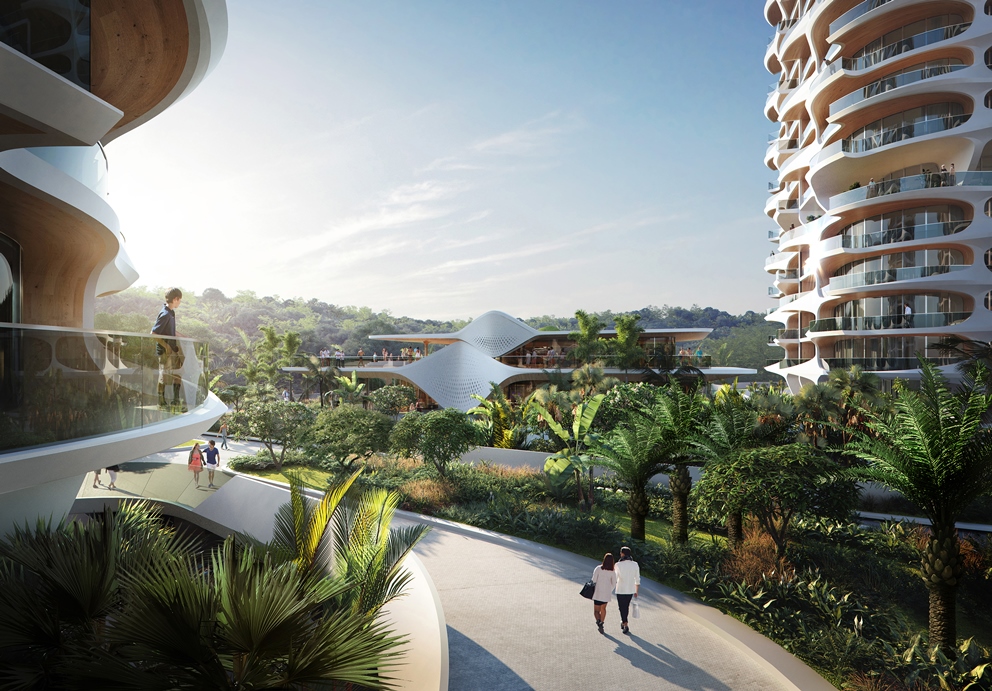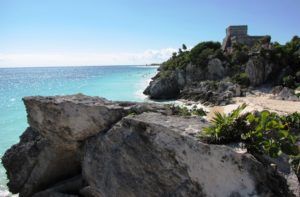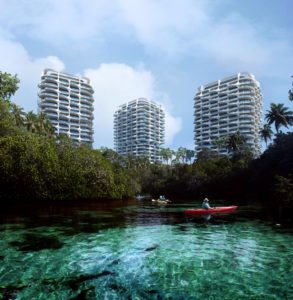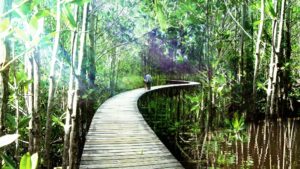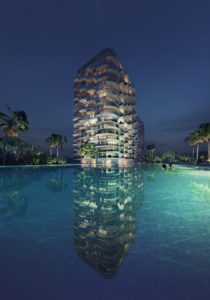Designed by famed London-based architectural firm Zaha Hadid Architects, in response to its natural surroundings, the Alai residential project in the Cancun hotel zone of the “Mayan Riviera” in the state of Quintana Roo marries ecological restoration, an engaging design, and a reinterpretation of local architectural tradition.
It does all of this on a site that was already in a state of ecological destruction, thanks to an earlier project that went nowhere (very common in Mexico, where it seems that anyone can start a speculative project, hoping to get the money to build from advance sales. My wife and I (Storm Cunningham) love the Yucatan peninsula, but every time we return to Quintana Roo, more of the gorgeous coast has been destroyed and shut-off to access by local citizens.
Often, the area has noting to show for the destruction. For instance, Chinese investors bought hundreds of acres of supposedly-protected mangrove forests just south of Cancun from Quintana Roo’s notoriously permissive state government.
They bulldozed the entire area, and then abandoned the project. Of course, the state didn’t demand a restoration deposit, so the formerly-beautiful, ecologically-vital area is now an ugly, muddy wasteland. Further down the Quintana Roo coast, the rampant, uncontrolled destruction of the formerly-gorgeous Tulum area is even worse.
The number of visitors to the Mayan Riviera is increasing by over 10% each year—surpassing 20 million arrivals in 2016, while its residential population has almost doubled since the year 2000. Welcoming more international visitors than any region in Latin America, it has become an important centre of business, tourism and transport.
The outstanding natural beauty, rich Mayan history and tropical climate of the Yucatan Peninsula continue to attract greater numbers of visitors from around the world every year. Accommodating this continued growth in popularity while also curtailing its impact on the environment must be the principal driver for all new projects in the region.
Located on a site cleared by the previous owner of a failed project, Alai’s design is guided by these principles of integrating a new residential community while also minimizing the effect on local ecosystems. The new design for the Pulso Inmobiliario , has significantly reduced its environmental impact by limiting the combined footprint of all residential buildings to less than 7% of the site’s total area, enabling existing vegetation to be retained and a majority of the site to be returned to its natural state through an ongoing program of replanting planned in conjunction with landscape architects, Gross Max.
An onsite botanical nursery will play a vital role in the restoration of species and ecosystems on the site that were disturbed by a previous owner, fostering growth of the site’s biodiversity. The dedicated work and activities of the nursery are planned to become an attraction and education facility in their own right.
The creation of a woodland nature reserve, together with the replanting of coastal wetland to protect and enhance the mangroves of the lagoon, will also include
a network of suspended footpaths to enable residents to access the woodlands, coast and lagoon without disturbing the ground.
The residential buildings share an elevated platform with integrated perforations, allowing natural light to flood the ground below and enabling tropical vegetation to grow upwards through the platform. Amenities for sport, leisure and wellness are located on this raised platform nine meters above the ground to ensure local wildlife can cross the entire site on the woodland floor without barriers. Being just above the canopy of the surrounding vegetation, residents and guests have views over the treetops to the Caribbean coast and lagoon beyond from all shared amenities.
The apartments are organised in four different floor typologies in response to the client brief and integrate generous living areas and bedrooms. The glazed exterior walls of each apartment open onto large private balconies with unobstructed views to the Caribbean Sea or Nichupté Lagoon, connecting each residence with the surrounding environment and maximizing the onshore trade winds of the region for natural ventilation.
Echoing the rich textures and surface complexity within the local Mayan masonry and architectural tradition derived from the repetition and variation of a small number of geometric components, the differing texture and patterning of each building’s façade within Alai is generated by assembling the balcony units and façade elements in varying sequences. This enables elements of relatively few different designs to create a unique facade for each building, yet maintains a cohesive design language throughout. These textured facade and balcony units provide solar shading to the apartments within.
Alai’s design is defined by its rich natural environment and reinterprets local Mayan heritage in a contemporary adaptation, responding directly to the challenges of the Yucatan Peninsula’s increasing popularity with visitors from around the world while at the same time fostering the conservation of its original natural woodland and coastal wetland.
Feature image via mir.no

